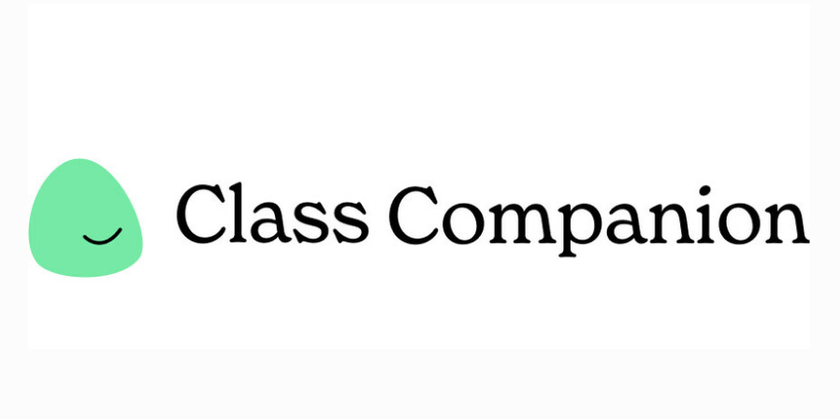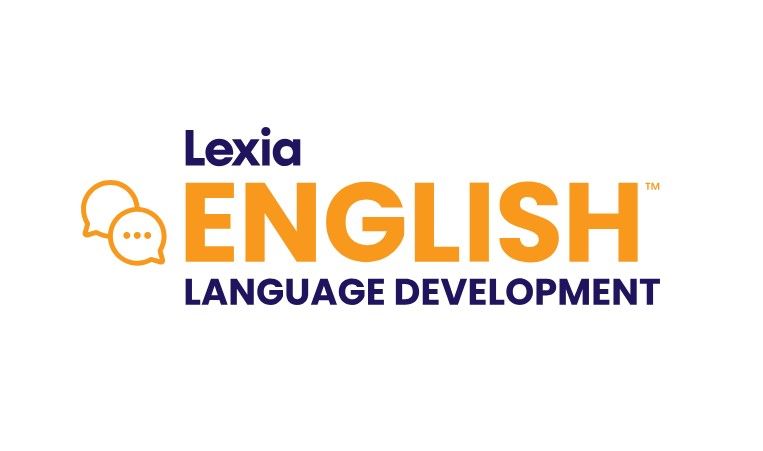Transitioning to Common Core
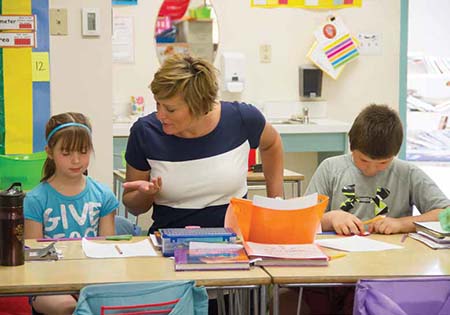
Products That Make It Easy
Randolph CSD’s superintendent, Kimberly Moritz, spends time with students as often as she can. Teachers in 43 states and DC are trying to figure out how to teach the Common Core State Standards in math and English language arts (ELA). Luckily, there are several technology products that can help teachers prepare their students to graduate with the skills they need to succeed—whatever path they choose. Here are some examples.
ADAPTIVE TECHNOLOGY TO THE RESCUE
New York State passed new requirements regarding teacher and administrator evaluations while it was transitioning to the Common Core. This would be a challenge for any district, but Kimberly Moritz used the transition as an impetus to drive change. “We had mediocre results for at least a decade before Common Core, so when the state required us to choose a local assessment, we got started right away,” says Moritz, superintendent of Randolph (NY) Central School District. The district began using Curriculum Associates’ Ready suite and i-Ready (www.curriculumassociates.com) because they were so closely aligned with the Common Core. Moritz says the company is like no company she’s ever known. “The Ready products let us intensively help students at all levels, and the Common Core lets us teach to everyone’s strengths.”
With i-Ready, students take adaptive tests four times a year in math and ELA to check their progress. Based on their scores, they are given personalized diagnostic instruction that they complete online. There are also print materials for teachers to use.
“Our assessments show that our students are improving, but when a veteran teacher tells me that students are learning more now, that’s worth everything,” Moritz says. “I spent time with high school students every day and I knew, a couple of years ago, the coursework wasn’t challenging for all of our students. I wanted our teachers to be able to push and challenge all learners, not just our struggling learners. Common Core is helping us to do that.”
Leyden students enjoy using their Chromebooks for everything1:1 PAVES THE WAY FOR COMMON CORE

Leyden (IL) High School District 212 is in in the third year of its 1:1 program with Dell Chromebooks. The district learned about technology integration and is now adopting Common Core State Standards simultaneously. “Web tools are extraordinarily useful for learning the language arts standards of speaking, listening, and researching,” says Dr. Mikkel Storaasli, assistant superintendent for curriculum and instruction. “For research alone, putting a Web-enabled device in each student’s hands gives him or her the opportunity to do any kind of research at any time.” Leyden students use EasyBib (www.easybib.com), Google Scholar (http://scholar.google.com), and a variety of online databases for research. They also use Google Apps for all sorts of writing assignments. Having Chromebooks available has increased the amount of writing for students as well as collaboration at all levels, says Storaasli. “They are no longer creating something on a piece of paper and tossing it aside. With Google Apps, pieces are constantly revised.”
Access to different levels of texts is a huge part of language arts, and—thanks to the Chromebooks—students are no longer limited to a single textbook. Teachers can find appropriate material for every level, including English language learners. The computers also allow teachers to use assessment tools like Socrative (www.socrative.com) or Kahoot (https://getkahoot.com) to get immediate feedback.
Web tools for math are advancing quickly as well, says Storaasli. Some classes use GeoGebra (www.geogebra.org), a hands-on program aligned to Common Core that allows students to manipulate objects to measure angles and better understand the relationships between objects. The Desmos Graphing Calculator (www.desmos.com/calculator) lets students learn about graphing functions, plot tables of data, and explore transformations. “Common Core is a huge shift for math teachers,” says Storaasli. “It’s complicated to find or create problems that match what the Common Core requires, so having Internet access makes it easier for teachers to network and find the resources our students need.”
Whether they’re in a classroom or the lab, Loridana Lopez’s 4th-grade students are becoming stronger readers, thanks to a variety of tech tools. READING IS ESSENTIAL IN COMMON CORE
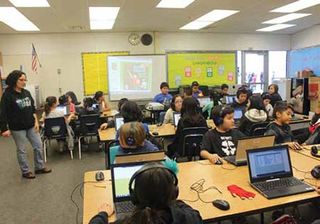
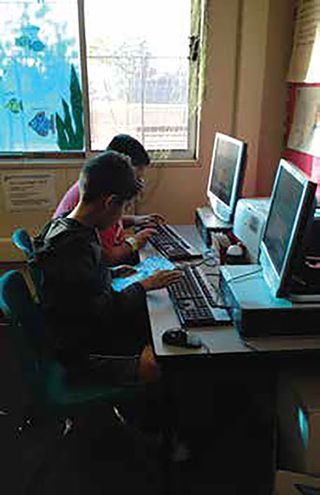
Buena Vista Arts-integrated Magnet in Montclair (CA), is a unique school in which the teachers have the opportunity to integrate the arts with their instruction. “Our goal is to get all of the students to read at grade level and beyond so that they can access entry to college one day,” says Loridana Lopez, a 4th-grade language arts and social studies teacher. In addition to integrating the arts for reading comprehension, Lopez uses technology to assist with the students’ achievement in the Common Core standards.
Lopez ensures that all students have access during the school day to get on a computer to read, research, or use one of the many resources available to learners. One of the primary programs she uses is Scholastic Reading Counts (http://teacher.scholastic.com/), a Lexile-based independent reading program that combines reading practices and assessment. “We use it as an incentive program for students to accumulate points and give them lots of recognition. They set their own goals and chart their growth.”
Two other programs Lopez relies on are EduTyping (www.edutyping.com) for keyboarding practice and Triumph Learning Common Core Support Coach (www.triumphlearning.com) for reading comprehension and foundational math skills. Lopez’s students use Common Core Support Coach two to three times a week. She loves that she can use it to teach entire units or assign a lesson for a student to do during computer time or at home if they have Internet access. She also loves that the software lets her run reports and see where each student is at any given time. “It’s a fantastic resource,” she says.
A 21ST-CENTURY EDUCATION PLAN
Robert C. Sidford joined the Washoe County (NV) School District two and a half years ago, just as Common Core was coming into play. Today, Nevada has rebranded Common Core as the Nevada Academic Content Standards (NVACS), which combines Common Core math and English language arts, next-generation science, and Nevada’s own standards into one package. As the 21st-century learning coordinator for the district, Sidford is in charge of determining how technology fits into the curriculum. “Instead of changing teaching, we’re trying to change learning,” he says. “For students to succeed at the Common Core assessments and show 21st-century competencies in collaboration, knowledge construction, and research, they need to practice those skills. That’s where the technology fits in.” He believes we’ve struggled to find an organic place for technology in education because we’ve focused on teaching instead of on learning. That’s why Washoe County is trying to help its teachers create student-centered learning environments in which students learn through technology—not about technology. One way students can do this is to select how they demonstrate understanding. They can write a paper, make a video, work in a team, or work independently. And the district is providing professional learning so teachers can understand how to make this happen.
So far, the district has created 21st Century Elevator Guides (www.wcsd21.com) focusing on real-world problem-solving and innovation, collaboration, 21st-century competencies, and other topics so that all 94 schools share a common approach to creating new classrooms. There’s a 21st-century learning leaders network of certified staff at every school to answer questions about technology and Common Core. Their goal is to be a resource for teachers and to help them integrate technology more effectively.
Although the district is not 1:1, largely due to the recession, they are laying the groundwork by preparing to go wireless over the next two years. Teachers who have already begun experimenting with technology are sharing ideas and helping other teachers get on board. Sidford is happy to witness this instructional shift and assist where he can. He says, “I believe we are ready to go to the next level and start to figure out how to have a district approach to integrating technology where it makes sense.”
TOOLS THEY USE
RANDOLPH (NY) CENTRAL SCHOOL DISTRICT
► Adobe Production Premium Suite
► Autodesk Inventor
► Castle Learning
► Curriculum Associates’ i-Ready Diagnostic and Instruction and Ready
► EduTyping
► IXL
► Microsoft Office 2013
► Scholastic Read 180
TOOLS THEY USE
LEYDEN (IL) HIGH SCHOOL DISTRICT 212
► Dell Chromebooks
► Google Apps for Education
► Pearson OpenClass LMS
► Teacher Dashboard from Hapara
TOOLS THEY USE
BUENA VISTA ARTS-INTEGRATED MAGNET (MONTCLAIR, CA)
► AverVision Document cameras
► EduTyping
► HP/Dell Laptops
► iRead
► IXL Math
► Microsoft Office
► Scholastic Reading Counts
► Scholastic SRI/SMI online assessments
► SMARTBoards
► Triumph Online Learning
TOOLS THEY USE
WASHOE COUNTY (NV) SCHOOL DISTRICT
► Adobe
► Cisco Infrastructure
► Dell desktops and laptops
►HP desktops and laptops
►Microsoft Office Suite, Productivity, and Office 365
► Promethean ActivBoards
QUICK FIXES
Looking for Common Core resources? Here are two recommendations:
■ Learning First Alliance (www.learningfirst.org/commoncore) has a rich collection of educator-focused Common Core resources, including podcasts, success stories, toolkits, and materials from its member organizations, including AA SA and AFT.
■ LearnZillion (https://learnzillion.com/free_resources) offers free, Common Corealigned lessons from math and English language arts teachers in grades 2-12.
SURVEY FINDS SIGNIFICANT NUMBER OF SCHOOLS ARE COMMON CORE READY
MDR’s new State of the K-12 Market 2014 report, conducted by the EdNET research team, defined trends that will have an impact on American schools in the coming year. Major findings in this year’s report include:
■ Common Core Standards Continue to Drive the Instructional Materials Market: Despite the swirling controversy surrounding CC SS, 43 states remain committed to implementation, and states that have not adopted or that have recently rejected the CC SS are still creating and implementing locally developed college- and career-ready standards.
■ Strong Technology Budgets: Nearly 90% of districts expect their 2014-2015 technology budgets for hardware, software, teacher training, and technical support to stay the same or increase.
■ Districts Move Forward on One-to-One Computing: Nearly half (44%) of all U.S. districts report that 1:1 computing is substantially implemented in high schools, 36% in middle schools, and 20% in elementary schools. Chromebooks have come on strong with half of all districts citing implementation of these newer devices.
■ U .S. Schools—No Strangers to Online Assessments: Fully a third of districts already administer the majority of student assessments in core content areas online, with an additional 25% expecting to reach that measure this year.
■ Experimentation Abounds for Flipped, Blended, and Personalized Models: 63% of districts have implemented flipped learning models in at least some classrooms, and 60% use a flexible blended model where students take all or a majority of courses online and teachers or paraprofessionals provide face-to-face support as needed.
■ Instructional Materials Making a Comeback: One out of four districts expects their 2014-2015 instructional budget to increase, up from 16% the prior year. Purchases of math instruction will be especially strong, with 43% of districts planning to purchase middle school products, 36% elementary, and 33% high school. ELA purchase expectations are almost as high for all grade levels.
To learn more, visit EdNET Insight (www.ednetinsight.com).
Tech & Learning Newsletter
Tools and ideas to transform education. Sign up below.


